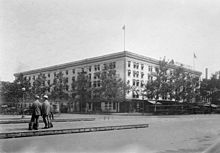- National Hotel disease
-
The National Hotel epidemic was a mysterious sickness which afflicted persons who stayed at the National Hotel in Washington, D.C. beginning in early January 1857.[1] The illness was considered by some medical experts to have originated from an attempt to poison hotel boarders. It affected mostly patrons of the hotel's dining room and not those who frequented the bar.[2] It began to spread more noticeably by the middle of January 1857.[1] In 1857 the National Hotel was the largest hotel in Washington, D.C.[3]
Major George McNeir, 64, of Washington, D.C., dined at the National Hotel at the time of the first outbreak of the epidemic. Dr. Jas J. Waring was among the physicians who performed an autopsy on McNeir. He was the only person whose body was subjected to a post-mortem examination after dying from the sickness. Waring stated that there was no incubation period before the onset of McNeir's illness. He was affected by the time he went to bed following dinner and the symptoms never left him until his death.[4]
Contents
Symptoms
The National Hotel epidemic manifested itself as a persistent diarrhea, which was often accompanied by an intense colic. Victims experienced sudden prostration along with nausea. The tongues of patients generally indicated an inflammation of the mucous membranes of their stomachs. Sufferers often complained of recurrences of symptoms even after leaving the National Hotel.[1] Aside from a sudden onset of diarrhea, which happened generally in the early morning, vomiting occurred after the diarrhea ceased.
Presidential coincidences
The National Hotel epidemic's first occurrence coincided with the President-elect of the United States James Buchanan's first visit to the National Hotel. When Buchanan returned home to Wheatland, reports of new cases of the sickness stopped. Upon his return two weeks later the illness returned with intensity. Buchanan was warned about eating and drinking at the National Hotel. He continued to reside there prior to moving into the White House. However he did not eat or drink there before taking office as President of the United States.
Theories of origin
A physician quoted by the Philadelphia, Pennsylvania "Times" vocalized the "poison" theory. However, dissenters contended that "rat" poisoned water was improbable because the National Hotel's water tank was only used for washing. Drinking water was brought to the establishment from a distance.[2] In an effort to eliminate rats from the National Hotel, arsenic was used. One of the poisoned rats was discovered in the water tank after guests became ill with the sickness.[5]
The Mayor of Washington, D.C., together with a committee chosen by the board of health, submitted a report which denied that any mineral poisoning was ingested in the stomachs of victims of the epidemic. There was no evidence of inflammation of the intestines. The committee contended that the disease was transmitted by inhalation of a poisonous miasma which originated from the decomposition of vegetables and animals. They thought the infection entered the National Hotel from a sewer which was connected to the Sixth Street sewer.
A sewer builder noticed a sewer opening in the southwest corner of the National Hotel which connected with the sewer loading into the street. Through this opening there proceeded a constant fetid gas. The gas was coming in rapidly enough to extinguish a candle flame according to this individual's estimation. The committee looked without finding evidence of water poisoning, food poisoning, or arsenic poisoning.[6]
Abatement and return
New cases of the National Hotel epidemic began to decrease in number by the end of January 1857 and continued to abate until the middle of February. When the numbers of guests increased for the presidential inauguration of March 4, 1857, the sickness returned again forcefully.[1] After other mishaps, including a fire in 1921, the National Hotel was acquired by the municipal government in 1929 and demolished in 1942.[7]
References
- ^ a b c d "The Washington Epidemic", New York Daily Times, March 23, 1857, pg. 2.
- ^ a b "The Washington Epidemic", New York Daily Times, April 3, 1857, pg. 5.
- ^ Redman, Brian Francis (2009). "What Would Millard Do?", Findings of the Friends of Millard Fillmore, pg. 53.
- ^ National Hotel Epidemic, American Journal of Medical Sciences, January 1858, Volume 69, Issue 1, pg. 97.
- ^ Columbia Historical Society of Washington, Vol. 57–59, 1961, pg. 120.
- ^ "The Washington Epidemic-Report of the Committee of the Board of Health", New York Daily Times, March 25, 1857, pg. 2.
- ^ Kent (2009-05-07). "Lost Washington: National Hotel". Washington Kaleidoscope. http://dckaleidoscope.wordpress.com/2009/05/07/lost-washington-national-hotel/. Retrieved 2011-01-20.
Further reading
- "The National Hotel Disease — Letter to Dr. D. H. Storer". Boston Med Surg J 56: 371–376. 1857.
Categories:- Epidemics
- History of Washington, D.C.
- Infectious diseases
- James Buchanan
- 1857 in the United States
- 19th-century health disasters
Wikimedia Foundation. 2010.

